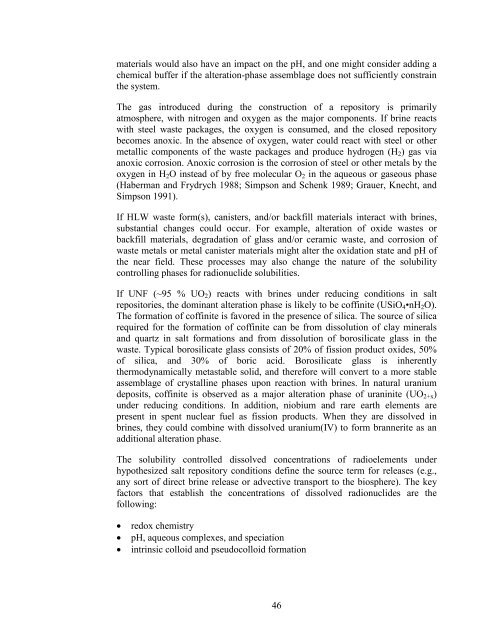Salt Disposal of Heat-Generating Nuclear Waste
Salt Disposal of Heat-Generating Nuclear Waste
Salt Disposal of Heat-Generating Nuclear Waste
Create successful ePaper yourself
Turn your PDF publications into a flip-book with our unique Google optimized e-Paper software.
materials would also have an impact on the pH, and one might consider adding a<br />
chemical buffer if the alteration-phase assemblage does not sufficiently constrain<br />
the system.<br />
The gas introduced during the construction <strong>of</strong> a repository is primarily<br />
atmosphere, with nitrogen and oxygen as the major components. If brine reacts<br />
with steel waste packages, the oxygen is consumed, and the closed repository<br />
becomes anoxic. In the absence <strong>of</strong> oxygen, water could react with steel or other<br />
metallic components <strong>of</strong> the waste packages and produce hydrogen (H 2 ) gas via<br />
anoxic corrosion. Anoxic corrosion is the corrosion <strong>of</strong> steel or other metals by the<br />
oxygen in H 2 O instead <strong>of</strong> by free molecular O 2 in the aqueous or gaseous phase<br />
(Haberman and Frydrych 1988; Simpson and Schenk 1989; Grauer, Knecht, and<br />
Simpson 1991).<br />
If HLW waste form(s), canisters, and/or backfill materials interact with brines,<br />
substantial changes could occur. For example, alteration <strong>of</strong> oxide wastes or<br />
backfill materials, degradation <strong>of</strong> glass and/or ceramic waste, and corrosion <strong>of</strong><br />
waste metals or metal canister materials might alter the oxidation state and pH <strong>of</strong><br />
the near field. These processes may also change the nature <strong>of</strong> the solubility<br />
controlling phases for radionuclide solubilities.<br />
If UNF (~95 % UO 2 ) reacts with brines under reducing conditions in salt<br />
repositories, the dominant alteration phase is likely to be c<strong>of</strong>finite (USiO 4 •nH 2 O).<br />
The formation <strong>of</strong> c<strong>of</strong>finite is favored in the presence <strong>of</strong> silica. The source <strong>of</strong> silica<br />
required for the formation <strong>of</strong> c<strong>of</strong>finite can be from dissolution <strong>of</strong> clay minerals<br />
and quartz in salt formations and from dissolution <strong>of</strong> borosilicate glass in the<br />
waste. Typical borosilicate glass consists <strong>of</strong> 20% <strong>of</strong> fission product oxides, 50%<br />
<strong>of</strong> silica, and 30% <strong>of</strong> boric acid. Borosilicate glass is inherently<br />
thermodynamically metastable solid, and therefore will convert to a more stable<br />
assemblage <strong>of</strong> crystalline phases upon reaction with brines. In natural uranium<br />
deposits, c<strong>of</strong>finite is observed as a major alteration phase <strong>of</strong> uraninite (UO 2+x )<br />
under reducing conditions. In addition, niobium and rare earth elements are<br />
present in spent nuclear fuel as fission products. When they are dissolved in<br />
brines, they could combine with dissolved uranium(IV) to form brannerite as an<br />
additional alteration phase.<br />
The solubility controlled dissolved concentrations <strong>of</strong> radioelements under<br />
hypothesized salt repository conditions define the source term for releases (e.g.,<br />
any sort <strong>of</strong> direct brine release or advective transport to the biosphere). The key<br />
factors that establish the concentrations <strong>of</strong> dissolved radionuclides are the<br />
following:<br />
• redox chemistry<br />
• pH, aqueous complexes, and speciation<br />
• intrinsic colloid and pseudocolloid formation<br />
46
















